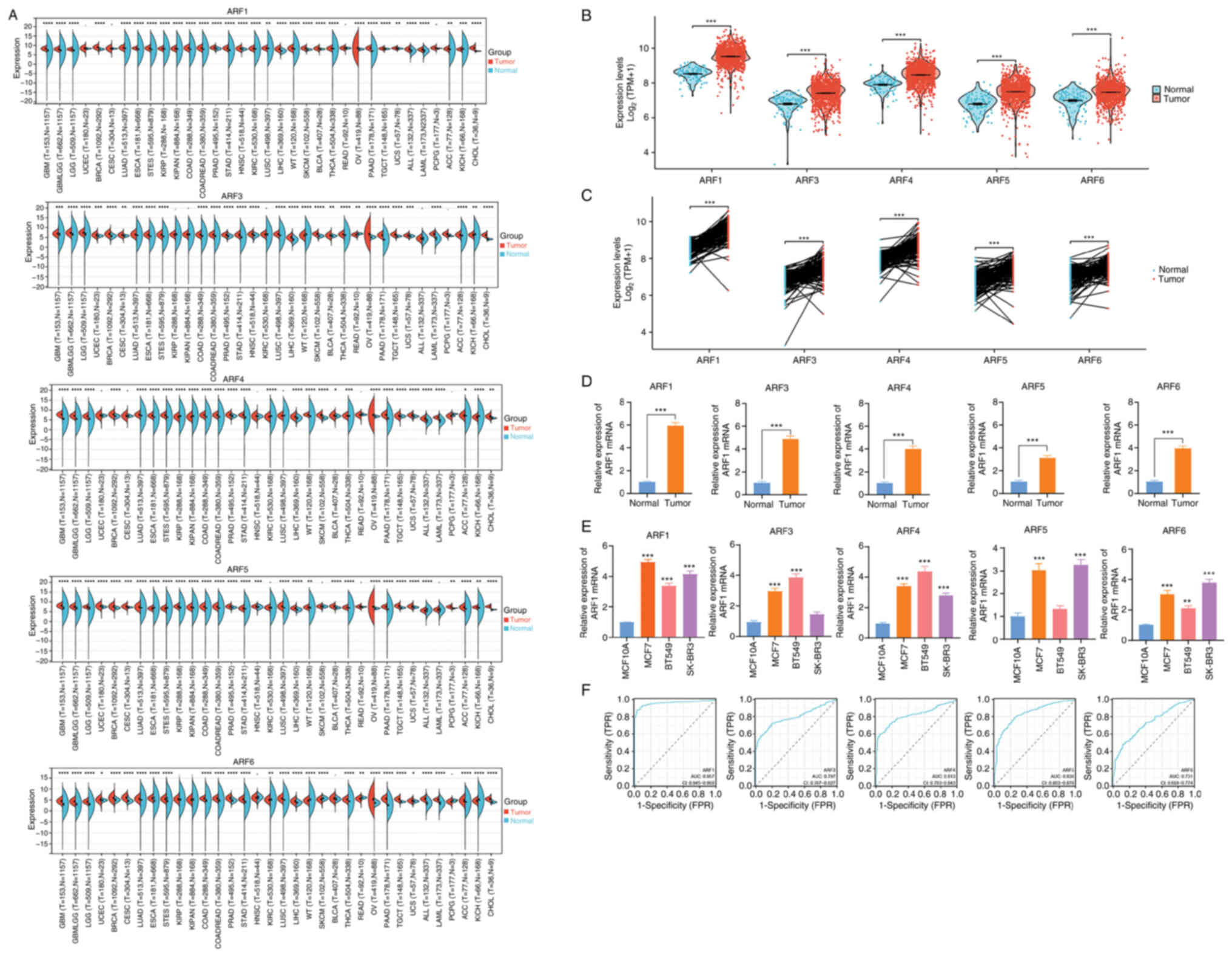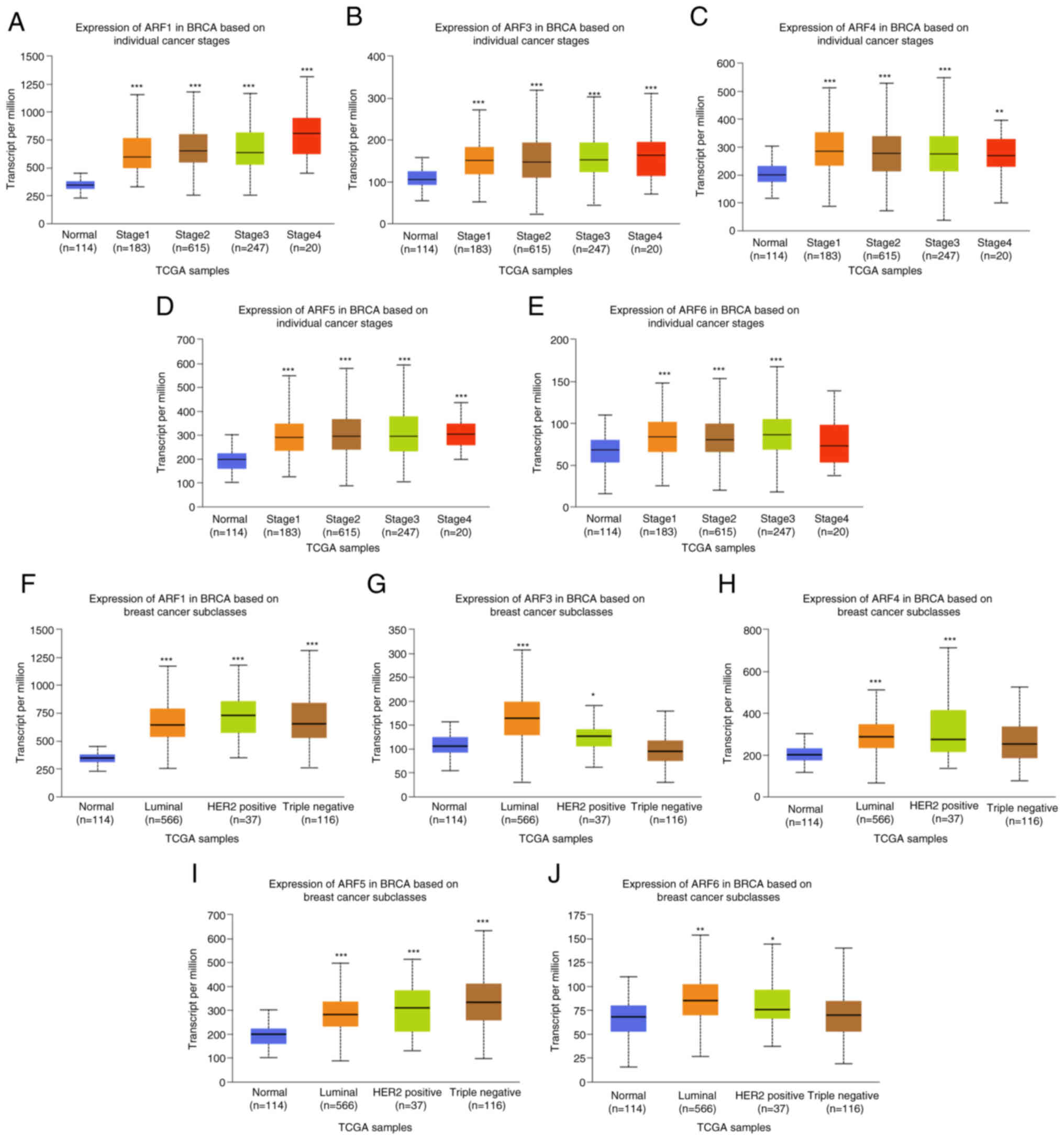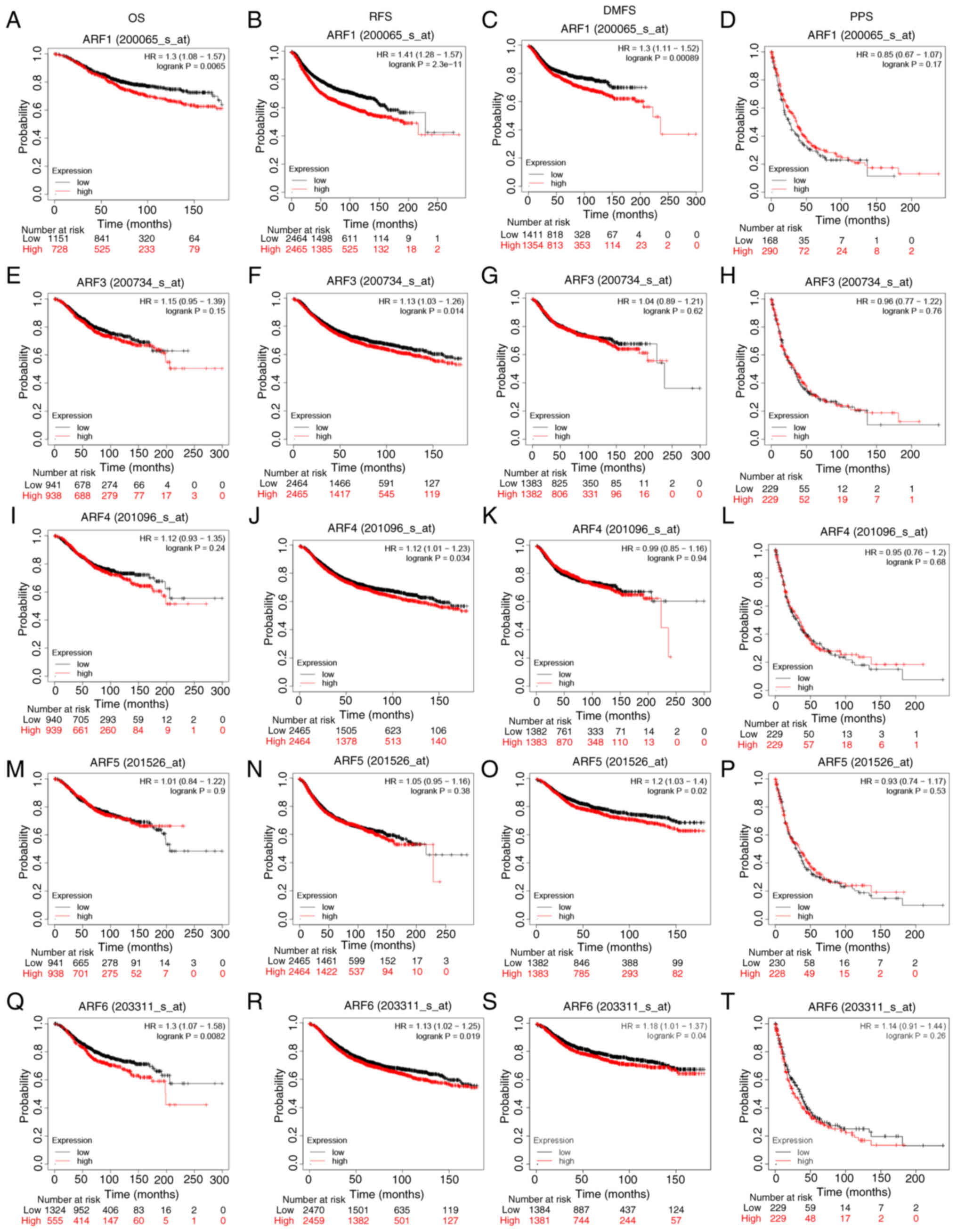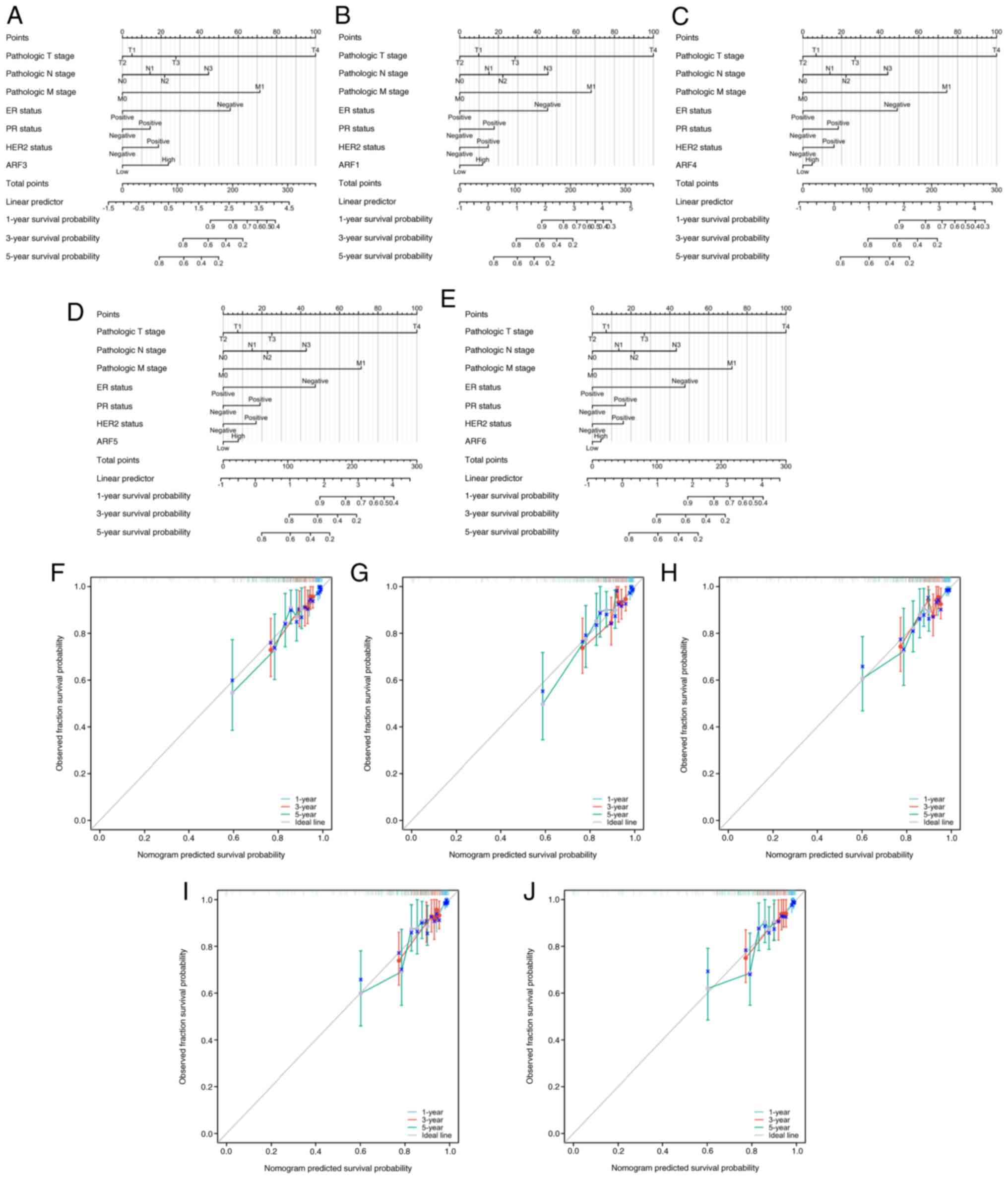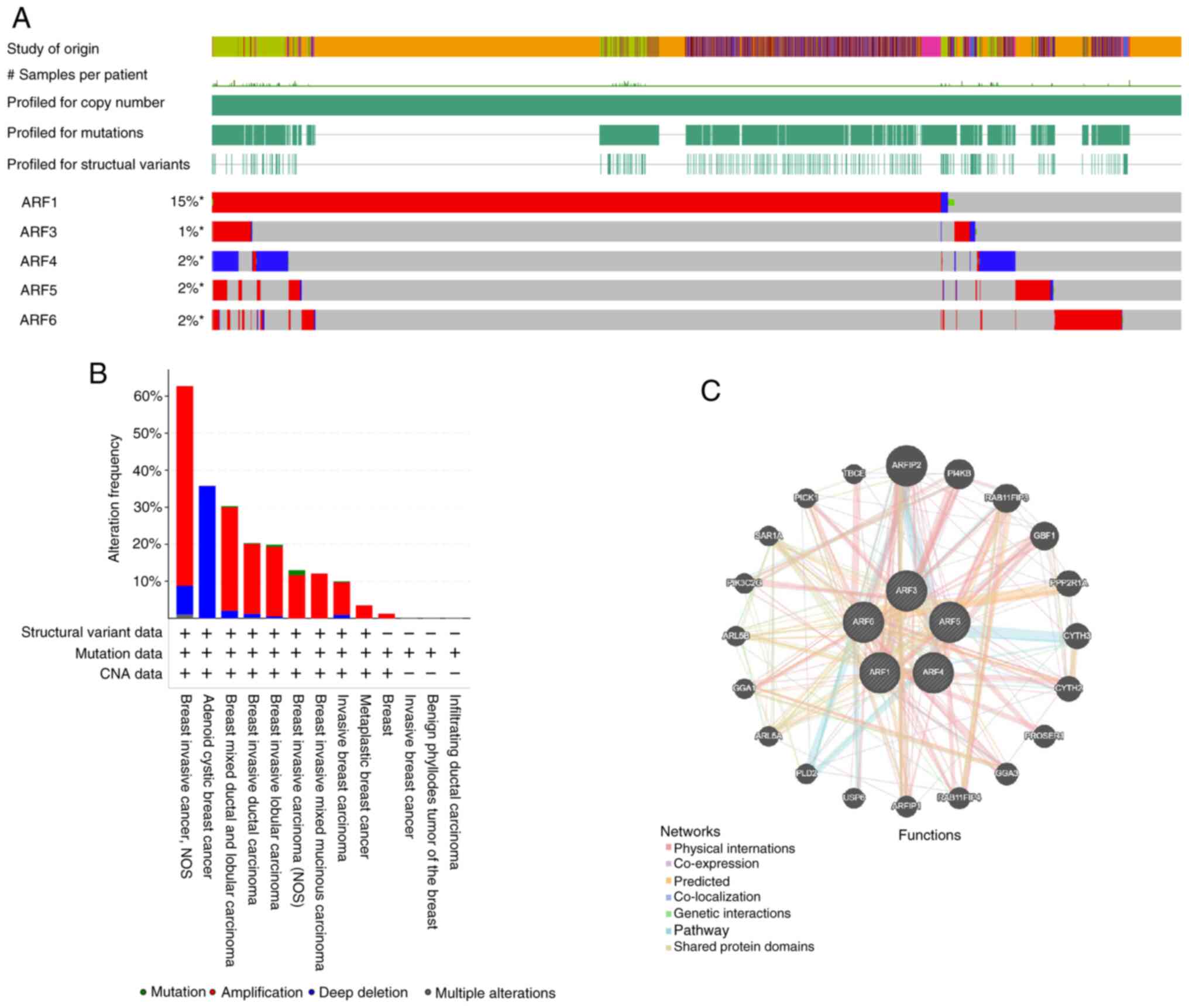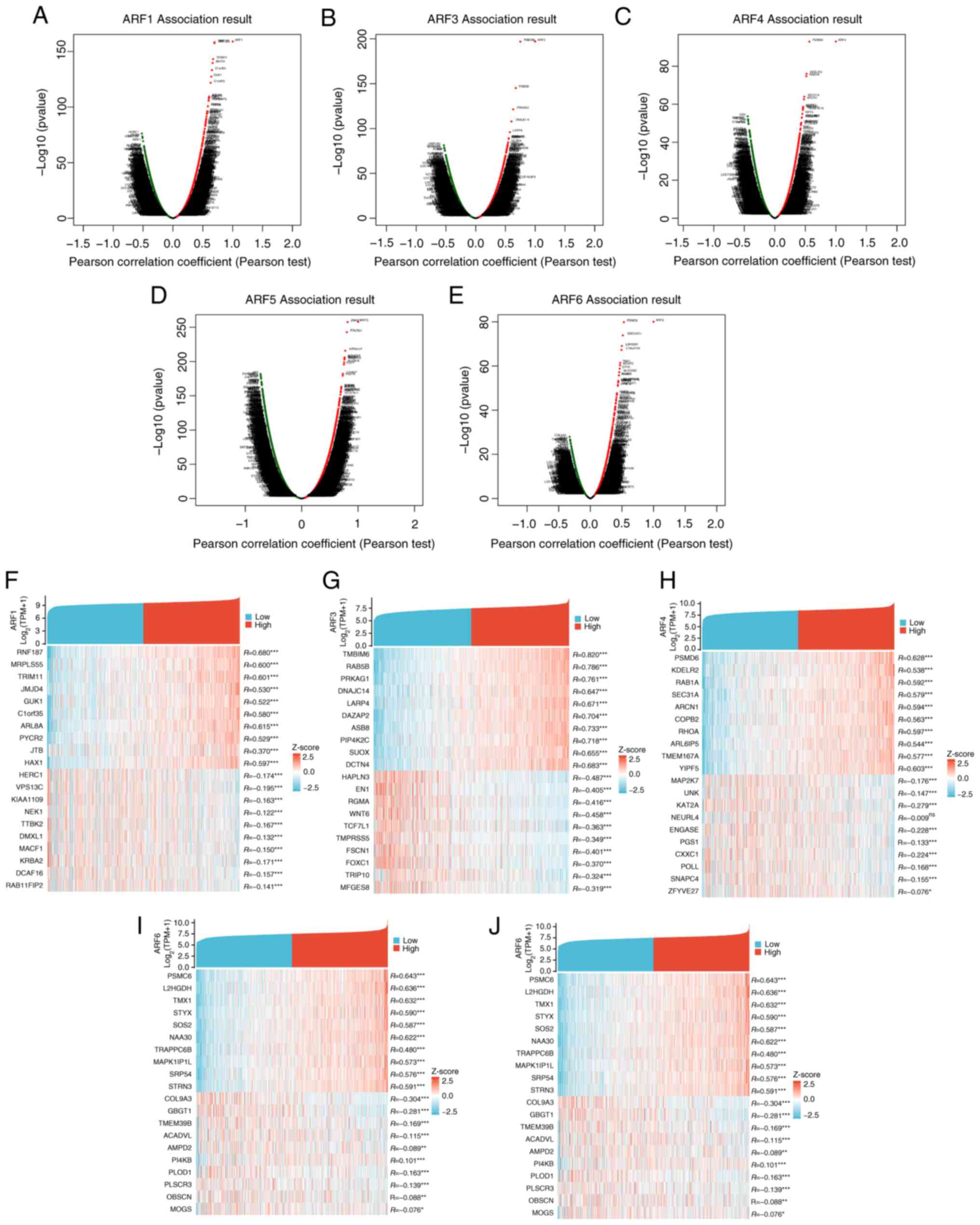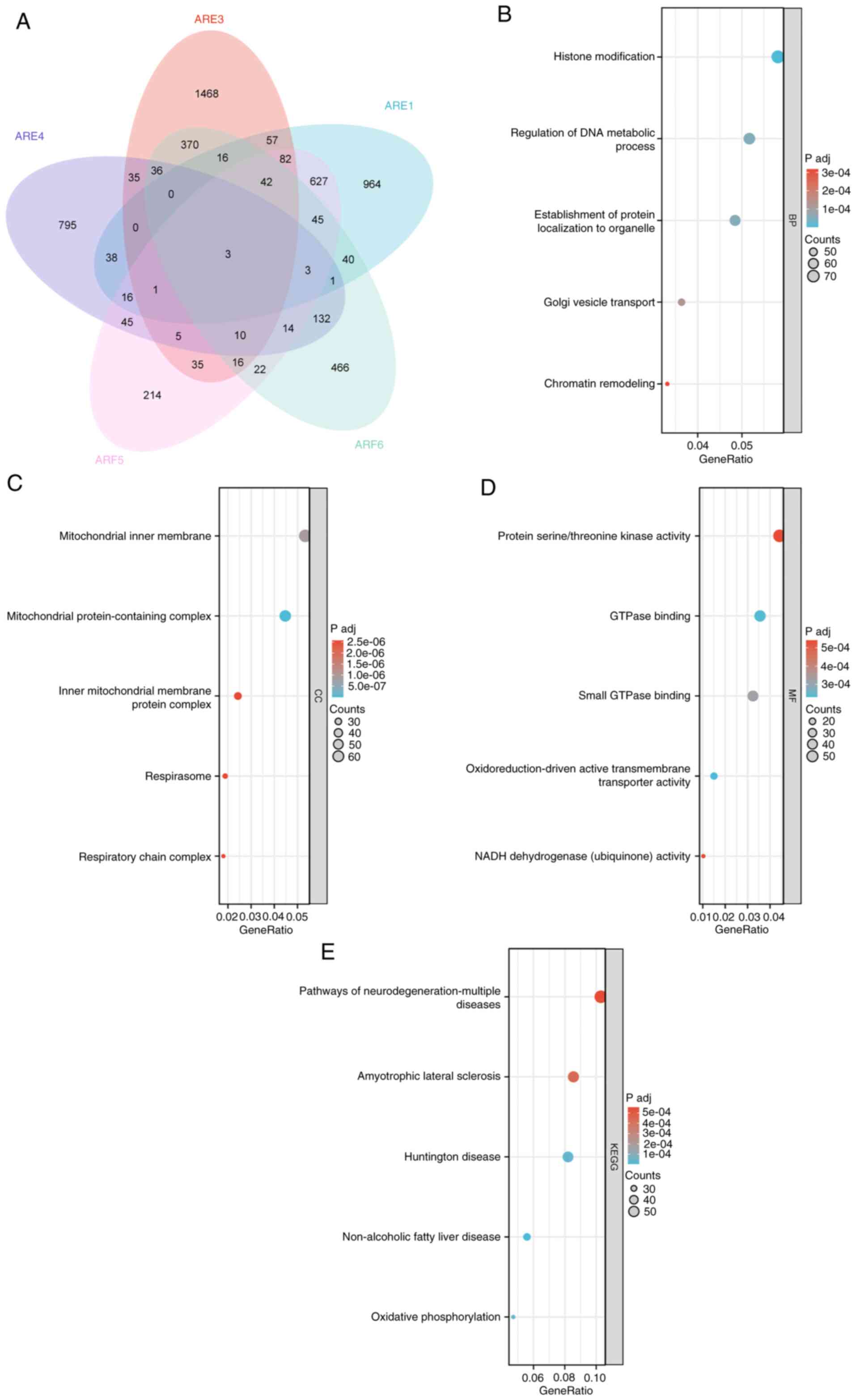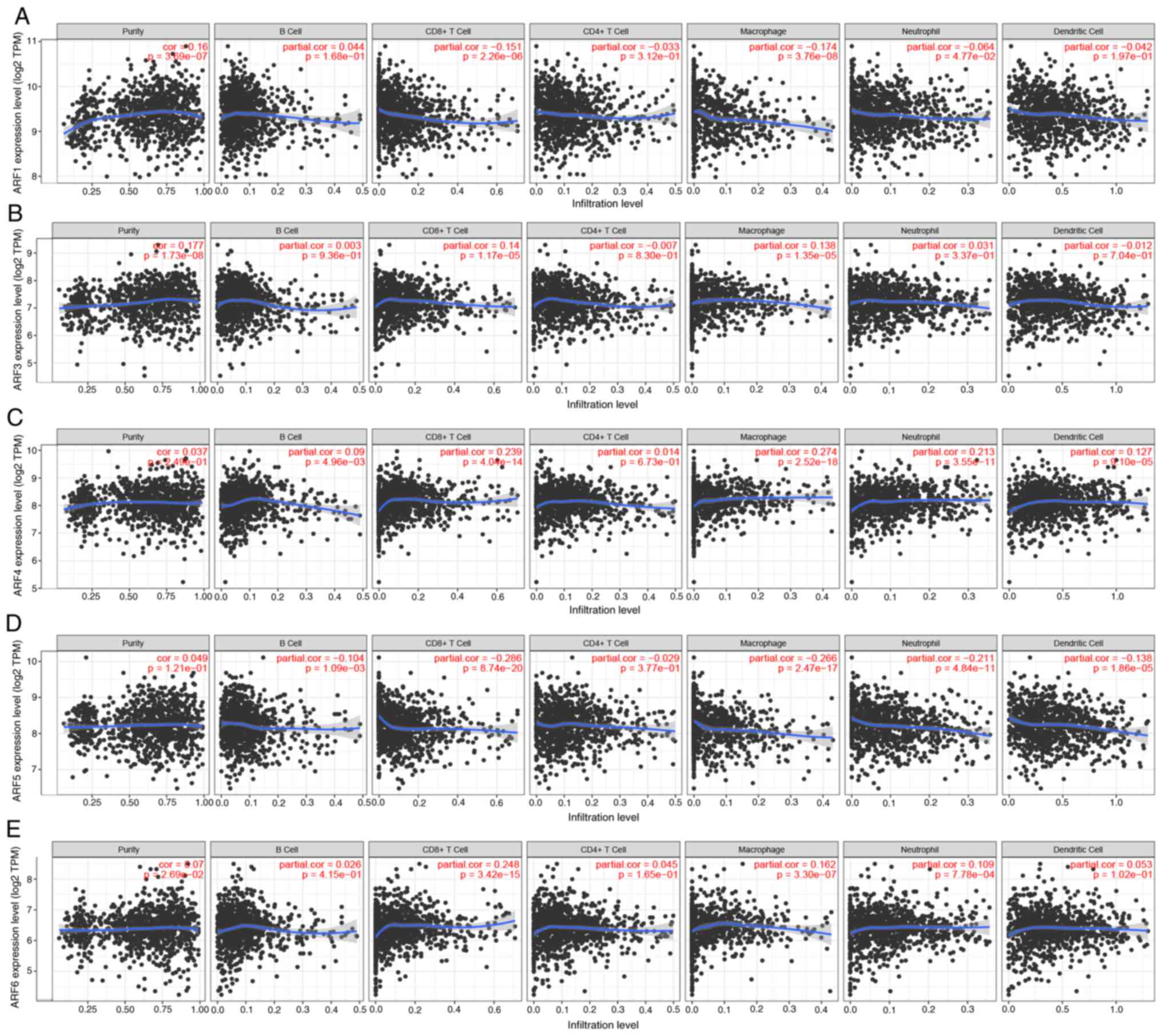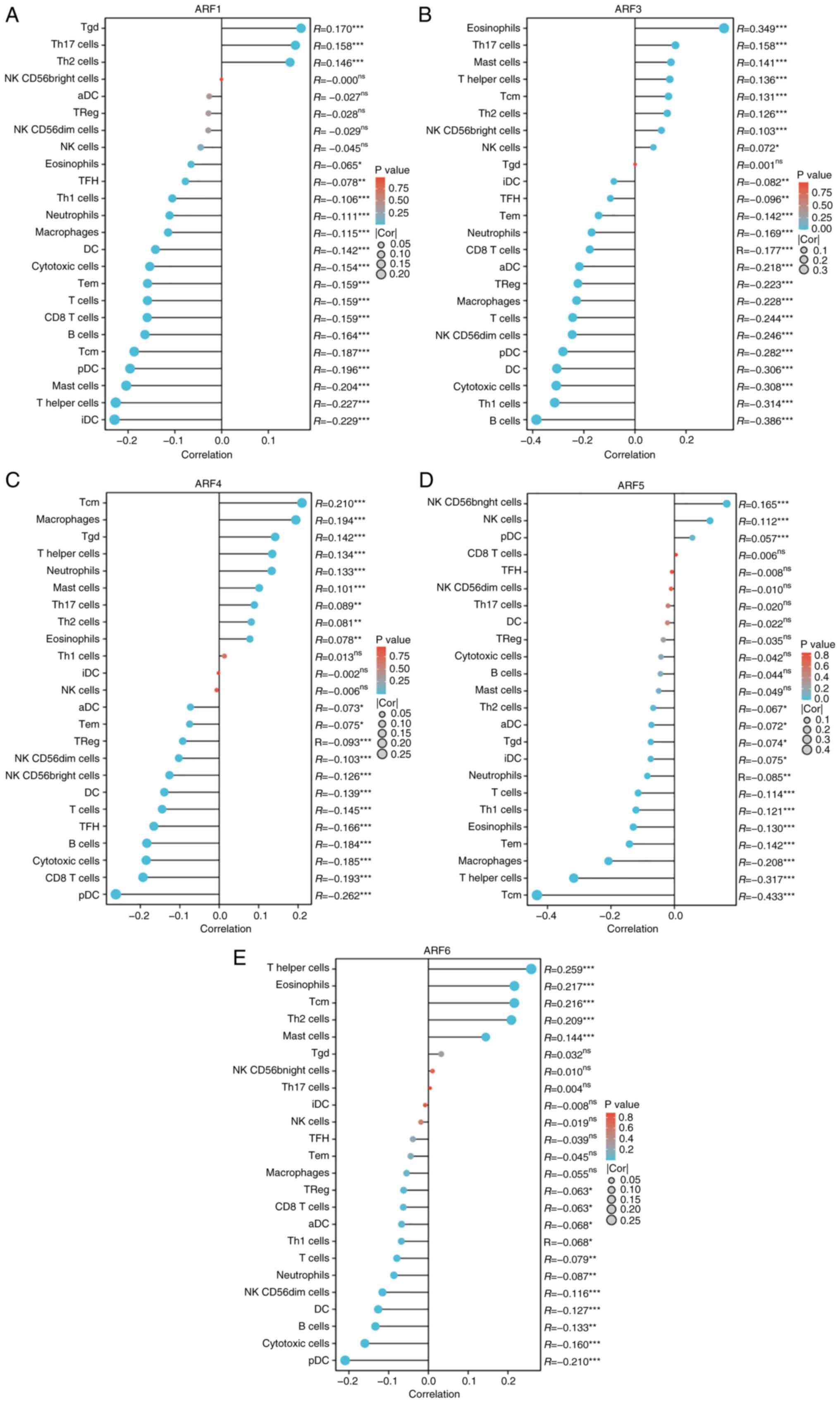Association of ADP‑ribosylation factor family genes with prognosis and immune infiltration of breast cancer
- Authors:
- Published online on: April 23, 2024 https://doi.org/10.3892/ol.2024.14413
- Article Number: 280
-
Copyright: © Yang et al. This is an open access article distributed under the terms of Creative Commons Attribution License.
Abstract
Introduction
In women, breast cancer (BC) is currently more widespread than lung cancer, as ~2.26 million new cases (11.7%) have been reported (1). This makes it the leading factor contributing to cancer-related fatalities among women globally (2). Despite the progressive techniques for early detection and the advancements in anti-cancer treatments, the reoccurrence and dissemination of BC continue to present substantial obstacles (3,4). Predicting BC prognosis is constrained by the limited scope of existing biomarkers, largely owing to the heterogeneous and complex nature of tumors (5). Hence, it is imperative to investigate novel molecular biomarkers in clinical research to improve prognostic accuracy and facilitate personalized treatment approaches (6).
ADP-ribosylation factors (ARFs) are small GTP-binding proteins that have a crucial role in regulating various cellular processes. Specifically, they function as molecular switches, activating signaling cascades involved in remodeling the actin cytoskeleton, altering membrane lipids and facilitating vesicle formation. In humans, there are six identified ARF proteins (ARF1 to ARF6), with the exception of ARF2, which is not expressed in humans. Among these isoforms, ARF1 and ARF6 have been extensively studied and are considered the most well-characterized. Traditionally, ARF1 has been associated with the Golgi apparatus, whereas ARF6 is primarily found in the plasma membrane. However, recent findings indicate that ARF1 can also be detected at the plasma membrane in certain cell types (7–9).
ARF isoforms can be classified into three groups: Class I (ARF1, ARF2 and ARF3), class II (ARF4 and ARF5) and class III (ARF6). The primary function of ARF1-3 is to regulate the transport of plasma membrane between the Golgi apparatus and endoplasmic reticulum (ER) (7,8). By contrast, the specific functions of ARF4-5 proteins remain unknown. However, various biochemical assays suggest that both class I and class II ARFs have crucial roles in the secretion pathway within the ER-Golgi system (9). ARF6, on the other hand, primarily participates in the regulation of plasma membrane transport and the assembly of intracellular actin. In addition to these roles, ARF6 also has significant physiological functions in regulating various fundamental biological processes, such as cytokinesis, cell adhesion, tumor formation, tumor-cell growth, invasion and metastasis (7,8,10).
To date, the precise roles and prognostic implications of distinct members within the ARF family in BC have remained elusive. As a result, in order to shed light on this matter, the current investigation aimed to evaluate the expression levels of ARFs in BC tissues in relation to normal breast tissues by conducting a range of database analyses. Furthermore, the study also delved into comprehending the particular functions and prognostic significance of select individual members of the ARF family in BC.
Materials and methods
RNA-sequencing data and bioinformatics analysis
The normalized RNA sequencing data and corresponding clinical characteristics were acquired from The Cancer Genome Atlas (TCGA) dataset called TCGA BRCA (https://tcga.xenahubs.net). To facilitate this process, access to the TCGA BRCA dataset was obtained through TCGA. The samples of BC tissue consisted of 1,097 cases, while 114 samples of healthy breast tissue were procured. For the high-throughput sequencing data, the fragments per kilobase per million fragments mapped reads method was utilized to estimate the levels of transcript expression.
Clinical tissues
Between August 2021 and November 2022, Xingtai People's Hospital (Xingtai, China) conducted surgical procedures on patients, from whom a collection of 20 pairs of BC tissues and adjacent non-tumor tissues was obtained. These patients, who were randomly selected, 20 females aged 28–65 years, had all been diagnosed with BC through pathological examination. Prior to surgery, none of the patients had received any treatment and written consent was obtained from all participants. Table I provides detailed clinicopathological information of the patients (age range, 28–65). The collected tissue samples were frozen in liquid nitrogen and stored at −80°C. The Ethics Committee of Xingtai People's Hospital [Xingtai, China; approval no. 2021(035)] authorized the present study, which adhered to the principles outlined in The Declaration of Helsinki.
Table I.Clinicopathological characteristics of patients with breast cancer (n=20) in the present study. |
Cell lines and cell culture
The MCF7, SK-BR3 and BT549 BC cell lines, which are derived from humans, were obtained from The Cell Bank of the Type Culture Collection of The Chinese Academy of Sciences. The MCF10A mammary epithelial cell line, which is considered normal, was also acquired from the same source. The SK-BR3, MCF-7 and BT549 cells were grown in DMEM (Invitrogen; Thermo Fisher Scientific, Inc.) supplemented with 10% fetal bovine serum (Invitrogen; Thermo Fisher Scientific, Inc.) and 1% penicillin/streptomycin solution. The MCF10A cells, on the other hand, were cultured using MCF-10A cell medium (Procell Life Science & Technology, Co., Ltd.). All cell lines were maintained and passaged in a standard cell culture incubator at a temperature of 37°C and a 5% CO2 environment in an atmosphere with saturated humidity.
University of Alabama at Birmingham Cancer data analysis Portal (UALCAN) database
Based on the TCGA database, the UALCAN website (http://ualcan.path.uab.edu/index.html) is a comprehensive tool for the analysis of cancer data. It offers detailed information on the mRNA expression levels of ARFs and the methylation levels of promoters in both BRCA tissues and normal tissues. Furthermore, UALCAN evaluates the correlations between ARF expression and clinicopathological parameters. To ascertain discrepancies between ARF mRNA expression and promoter methylation levels in BC and healthy controls, the analysis utilized Welch's t-test. Furthermore, to compare the expression of ARFs among different tumor substages, the analysis employed one-way ANOVA followed by Dunnett's multiple-comparison test. P<0.05 was considered to indicate a statistically significant difference.
ARFs-related gene function enrichment analyses
The R package DESeq2 (version 1.26.0) (https://cloud.r-project.org/). was used to examine differentially expressed genes (DEGs) in the present analysis. The criteria for considering genes as differentially expressed included a log2 (fold change)>2 threshold and their adjusted P-value of <0.05. To determine the potential functions of genes associated with DEGs, Gene Ontology (GO) and Kyoto Encyclopedia of Genes and Genomes (KEGG) analyses were conducted. These analyses were performed in the TCGA database using the R packages org.Hs.eg.db (version 3.10.0) and clusterProfiler (version 3.14.3).
Reverse transcription-quantitative (RT-q)PCR
RNA was extracted from the cell lines using the Total RNA Extraction Kit from Qiagen GmbH. In order to synthesize cDNA, the HiScript®III First-Strand cDNA Synthesis Kit (+gDNA wiper) from Vazyme Biotech Co., Ltd. was used, following the instructions provided by the manufacturer. Subsequently, qPCR was performed using the ChamQ Universal SYBR qPCR Master Mix, also from Vazyme Biotech Co., Ltd. All of the kits/mixes mentioned above were used according to the manufacturer's instructions. The primers utilized in this process were synthesized by Sangon Biotech Co., Ltd. The qPCR program included a pre-denaturation step at 95°C for 30 sec, followed by 40 cycles of 95°C for 5 sec and 60°C for 30 sec. Table II contains the sequences of the β-actin and ARF primers. The cycle thresholds were recorded and the 2−∆∆Cq method (11), with β-actin serving as the reference gene, was used to determine and measure the relative expression levels of the target genes.
Tumor immune estimation resource (TIMER)
The TIMER 2.0 web interface (https://cistrome.shinyapps.io/timer/) is a user-friendly tool designed for scientific analysis. It offers six analysis modules that facilitate the comprehensive evaluation of various immune cell infiltration types and their potential clinical significance. By utilizing the gene module, ARFs were chosen as the input and scatterplots were produced to visually depict the relationship between their expression levels and the extent of immune infiltration in BC.
cBioPortal
cBioPortal (http://www.cbioportal.org) is a web-based platform that offers a comprehensive range of cancer genomics data, ensuring multidimensional visualization and access. The accession date was Dec 29, 2023. The present study aimed to scrutinize the gene mutations of ARFs within the context of BRCA, leveraging the functionalities present in this resource.
GeneMANIA
GeneMANIA (http://www.genemania.org) is an abundantly resourced website dedicated to the provision of gene data, analysis of gene lists and the application of a sophisticated prediction algorithm to prioritize gene function analysis. The utilization of GeneMANIA was instrumental in the creation of the ARF interaction networks.
STRING
The STRING online database (https://string-db.org/) is a website for the investigation of protein-protein interactions (PPIs). Through the PPI network analysis of STRING, the different expression levels and potential PPIs of ARFs were identified and assessed.
Statistical analysis
The statistical analysis of the data collected was performed using GraphPad Prism software (version 8.0; Dotmatics) and R (version 3.6.3). The transcriptional data and clinical data for BRCA were obtained from the TCGA database. Comparisons between or among groups were performed using an unpaired Student's t-test, paired Student's t-test or one-way ANOVA. Tukey's HSD was used as a post hoc test following ANOVA. One-way Cox regression analysis was conducted on these datasets using the R software package ‘Forestplot’ (version 2.0.1). In addition, receiver operating characteristic (ROC) curves were generated using the ‘pROC’ package (version 1.18.0) in R. Kaplan-Meier analysis were performed with log-rank test. Furthermore, multivariate analysis was carried out using the ‘survival’ package (version 3.2, year 13) in R to assess various aspects of survival including overall survival (OS), distant metastasis-free survival (DMFS), post-progression survival (PPS) and recurrence-free survival (RFS). The correlation between ARFs expression and immune infiltration was determined using Spearman's correlation analysis. P<0.05 was considered to indicate statistical significance.
Results
Expression profile of ARF gene family in BRCA
Fig. 1A shows the expression pattern of all ARF gene family members in the TCGA pan-cancer panel. Various malignancies, such as breast invasive carcinoma (BRCA), glioblastoma multiforme, glioma, brain lower grade glioma, lung adenocarcinoma, esophageal carcinoma, stomach and esophageal carcinoma, kidney renal papillary cell carcinoma, pan-kidney cohort, colon adenocarcinoma, prostate adenocarcinoma, stomach adenocarcinoma, head and neck squamous cell carcinoma, kidney renal clear cell carcinoma, lung squamous cell carcinoma, liver hepatocellular carcinoma, skin cutaneous melanoma, bladder urothelial carcinoma, ovarian serous cystadenocarcinoma, pancreatic adenocarcinoma, testicular germ cell tumors, uterine carcinosarcoma, acute myeloid leukemia, adrenocortical carcinoma, kidney chromophobe and cholangiocarcinoma exhibited a significant upregulation of ARF1, ARF3, ARF4, ARF5 and ARF6. Furthermore, the mRNA expression levels of the ARF gene family were notably higher in BRCA samples than in normal mammary samples (P<0.001), as indicated by both unpaired and paired sample analyses (Fig. 1B and C). This consistency in the findings was also observed in our tissue sample library and collection of cell lines (Fig. 1D and E).
Furthermore, in order to assess the diagnostic efficacy of the ARF gene family in relation to BRCA, an ROC curve analysis was employed. The variables of ARF1, ARF3, ARF4, ARF5 and ARF6 revealed a heightened level of accuracy when differentiating between healthy controls and BC samples (area under the curve=0.957, 0.797, 0.813, 0.838 and 0.731) (Fig. 1F).
Association between ARFs and cancer stage and subclass of BC
Data from the UALCAN database demonstrated that the expression levels of ARF1 (Fig. 2A), ARF3 (Fig. 2B), ARF4 (Fig. 2C) and ARF5 (Fig. 2D) in breast cancer tissues of all stages was higher than that in normal breast tissues. However, the expression level of ARF6 in stage 4 BC was not significantly different from that of normal breast tissue (Fig. 2E). Furthermore, the expression of ARF1 (Fig. 2F), ARF3 (Fig. 2G), ARF4 (Fig. 2H), ARF5 (Fig. 2I) and ARF6 (Fig. 2J) was higher in almost all molecular subtypes of BC than in normal breast tissue.
Prognostic and diagnostic value of ARF mRNA expression in patients with BC
In order to determine the value of differently expressed ARFs in determining the progression of BC, the association between various ARFs and clinical outcomes was evaluated using Kaplan-Meier plots (Fig. 3). It was observed that high expression of ARF1 demonstrated a significant association with decreased OS (Fig. 3A) and DMFS (Fig. 3C) among patients with BC. Furthermore, elevated mRNA expression levels of ARF1 (Fig. 3B), ARF3 (Fig. 3F), ARF4 (Fig. 3J) and ARF6 (Fig. 3R) displayed significant associations with shorter RFS times in patients with BC. Interestingly, a higher expression level of ARF5 (Fig. 3O) and ARF6 (Fig. 3S) predicted a decrease in DMFS among patients with BC. In addition, a heightened mRNA expression level of ARF6 (Fig. 3Q) was found to be significantly associated with decreased OS times in patients with BC, while the other associations of ARFs did not yield significant results (Fig. 3).
Nomograms and calibration curves of ARFs
In order to assess the predictive performance of ARFs, nomograms and calibration curves were constructed by incorporating the expression of ARFs to forecast survival at 1, 3 and 5 years (Fig. 4). The nomogram (Fig. 4A-E) simplified the determination of each gene's contribution by leveraging its expression level. Subsequently, the cumulative score for an individual patient was obtained by summing up the scores associated with all the genes. As per the nomogram, ARF3 exerted the most significant impact on the prognosis of OS. Of note, the calibration curves for 1-, 3- and 5-year survival displayed a high degree of concordance between the projected and observed outcomes, suggesting precise predictions of OS by the nomogram (Fig. 4F-J).
Gene expression changes in ARFs were assessed and an analysis of ARF gene expression and interaction in individuals diagnosed with BRCA was then performed. To analyze the influence of genetic modifications on the expression of ARF family genes in BC, the cBioPortal web tool was utilized. The examination revealed that the ARF family members ARF1, ARF3, ARF4, ARF5 and ARF6 exhibited alterations in 15, 1, 2, 2 and 2% of the BC samples, respectively (Fig. 5A and B). These analyses demonstrate that expression of ARFs is significantly amplified in various BC tissues, such as in breast invasive cancer, non-specific type, breast mixed ductal carcinoma, breast invasive lobular carcinoma, and metaplastic BC, further suggesting potential associations of ARFs with BC.
Following this, a network analysis of protein-protein interactions (PPI) was conducted using the STRING website to explore potential interactions among the differentially expressed ARFs. The PPI network (Fig. 5C) demonstrated the presence of numerous nodes and edges. The top 10 most related genes to the ARF family were as follows: ARFIP2, PI4KB, RAB11FIP3, GBF1, PPP2R1A, CYTH3, CYTH2, PROSER1, GGA5 and RAB11FIP4.
BC TCGA, GO and KEGG analyses of ARFs and their co-expressed genes
The DEseq2 R software package in the TCGA database was utilized to examine the expression levels of genes in individuals with BC displaying either high or low ARF expression. Through this analysis, the top 10 genes that exhibited positive or negative correlations with ARFs in BC were determined (Fig. 6). To gain further insight, a Venn diagram (Fig. 7A) was employed to analyze the DEGs to show the cross between DEGs of various members of the ARF family. GO and KEGG enrichment analyses using the top 100 DEGs that were mainly positively correlated with ARFs were subsequently performed. The condensed information obtained from the GO analysis encompassed the categories biological process, cellular component and molecular function. The findings revealed that ARFs and their interacting genes primarily participated in crucial processes such as ‘histone modification’, ‘regulation of DNA metabolic activity’, ‘mitochondrial inner membrane function’, ‘GTPase binding’ and ‘small GTPase binding’ (Fig. 7B-E).
ARF and immune-cell infiltration in patients with BC
Previous reports have indicated a connection between the concentration of immune cells and the growth and advancement of cancer cells (12). The present study utilized the TIMER database to investigate the link between ARF members and the invasion of immune cells. The results demonstrated a significant positive association between the expression of ARF1 and the invasion of CD8+ T cells, macrophages and neutrophils in patients with BC (Fig. 8A). Similarly, ARF3 showed a positive association with the invasion of CD8+ T cells, and a negative association of macrophages in patients with BC (Fig. 8B). Furthermore, the expression of ARF4 displayed a positive correlation with the invasion of B cells, CD8+ T cells, macrophages, dendritic cells and neutrophils in BC (Fig. 8C). Conversely, the expression of ARF5 exhibited a significant negative correlation with B cells, CD8+ T cells, macrophages, neutrophils and dendritic cells in patients with BC (Fig. 8D). Lastly, the expression of ARF6 in BC exhibited a significant positive correlation with the invasion of CD8+ T cells, macrophages and neutrophils (Fig. 8E).
In order to further evaluate the impact of ARFs on the tumor immune microenvironment (TIME), a Spearman's correlation analysis was performed to examine the connection between ARFs and the infiltration of immune cells. The results of this analysis revealed that there were both positive and negative correlations between ARFs and various immune cell types. For example, iDC was negatively correlated with ARF1, ARF3 and ARF5. For instance, a negative correlation between T cells and all ARFs was consistently observed (Fig. 9).
Discussion
Given the limitations of current prognostic indicators, including estrogen receptor, progesterone receptor, human EGFR 2, Ki67 and grade, due to the diverse nature of BC, it becomes imperative to identify new prognostic biomarkers that can improve individualized therapies. Therefore, the present study aimed to investigate the potential of ARF family genes as novel biomarkers for BC prognosis. This research endeavor marks the pioneering effort in exploring the utility of ARF family genes in this context.
Bioinformatics analysis is the scientific field that explores biology through the utilization of informatics, applied mathematics, computer science and statistics (11). Within this research, a bioinformatics analysis was conducted to examine the presence of ARF members in BC, investigate signaling pathways in BC, explore immune-cell infiltration in the BC microenvironment and assess its impact on the prognosis of patients with BC. Through analysis of data acquired from the TCGA database, alongside the examination of ARF expression levels in tissues collected from patients with BC as well as BC cell lines, it was identified that the five members of the ARF family exhibit higher expression in BC as compared to normal breast tissue. BC has the capability to induce local immune dysregulation by suppressing innate and adaptive immune responses (12). The immune microenvironment of a tumor, known as the TIME, holds significant importance within the overall tumor microenvironment. It exhibits high levels of heterogeneity and serves a critical function in both tumor progression and disease prognosis across different types of cancers (13). Therefore, achieving an accurate disease classification based on the TIME is of utmost importance, not only for assessing prognosis but also for guiding treatment decisions. Substantial evidence indicates that subsets of CD8+ T cells have crucial roles in controlling tumors, as evidenced by the correlation between the quantity of CD8+ T cells present in the tumor prior to therapy and the response to programmed cell death 1 treatment (14). Furthermore, the present results substantiated that there is a significant association between the heightened expression of the immune infiltration level of CD8+ T cells and macrophages and ARF family members, except ARF5. This finding offers valuable insight into the potential effectiveness of future immunotherapeutic approaches for BC.
In a study conducted by Lewis-Saravalli et al (15), it was demonstrated that the regulation of cell migration in highly invasive cancer cells is mediated by the interaction between Rac family small GTPase 1 and insulin receptor substrate of 53 kDa, involving the protein ARF1. The present investigation confirmed a positive association between the increased expression of ARF1 and reduced OS, RFS and DMFS in patients with BC.
Unlike other ARFs, ARF3 has five exons and four introns. It selectively associates with recruiting the Golgi shell complex and activating phospholipase D and PI kinase (16,17). There is accumulating evidence suggesting that ARF3 may have a crucial role in the development of cancer (18,19). A previous study indicated that the expression levels of ARF3 are positively associated with the clinical staging of BC (20). In a study focusing on GC, Chang et al (18) utilized microarray assays and identified APF3 as one of the central genes involved in regulating liver metastasis of gastric cancer. In the present study, Kaplan-Meier plotter analysis was used to confirm the significance of high ARF3 expression in the prognosis of human BC. In addition, the higher the expression of ARF3, the shorter the RFS in patients with BC observed.
In human glioblastoma cells, previous studies have shown that ARF4 has a vital role in activating phospholipase D and inhibiting the generation of reactive oxygen species, making it a crucial anti-apoptotic protein (21–23). To further investigate its significance in BC, Kaplan-Meier plotter analysis was utilized to assess the prognostic relevance of ARF4. The results indicated a negative association between high ARF4 expression and RFS in patients with BC, highlighting its potential as a promising biomarker for this condition.
However, the plasma membrane and various endosomes are the specific locations where ARF6 is found. In addition to its crucial involvement in membrane trafficking, ARF6 also governs membrane-associated pathological undertakings, such as the creation of membrane ruffles, elongation of neurites, as well as cellular migration and infiltration (24–26). In a clinical context, heightened expression of ARF6 and the stimulation of its subsequent signaling pathways have been detected in diverse tumor categories, correlating with inferior OS rates (27,28). Examples of such malignancies encompass BC, lung adenocarcinoma and head and neck cancers (29–31).
Analysis of ARF family-related proteins identified ARFIP2, PI4KB, RAB11FIP3, GBF1 and PPP2R1A as proteins with strong correlations. ARFIP2 regulates epithelial to mesenchymal transition and autophagy through the PI3K/AKT pathway in hepatocellular carcinoma (31), whereas PPP2R1A promotes cancer development through the SRC-JNK-c-Jun pathway (32), and the ARF family may also regulate BC development through related mechanisms, which need to be verified by further studies.
Furthermore, GO analysis was employed to investigate the biological processes associated with the gene family of ARFs and their interacting counterparts. The findings revealed the predominant involvement of ARFs and their interacting genes in diverse physiological activities, including histone modification, regulation of DNA metabolic processes, mitochondrial inner membrane functionality, GTPase binding and small GTPase binding. Furthermore, KEGG analysis supported the concentration of the gene family of ARFs and their interacting genes in conditions such as amyotrophic lateral sclerosis and Huntington's disease. Overall, these results indicate a potential link between the aberrant expression of ARFs and its interacting genes and the regulation of DNA metabolic processes, as well as GTPase binding. Results analyzed by the ibioportal database showed that there may be differences in gene expression and deletion of ARFs in different studies, which may be due to the heterogeneity of BC. As for the reason for this difference, this may be the focus of further research efforts by our group.
The present study aimed to investigate the presence of ARFs in BC, which holds significant importance in predicting the prognosis of patients with BC. Overexpression of these genes often contributes to a more aggressive form of BC. All five members of the ARF gene family are anticipated to serve as crucial biomarkers for the diagnosis and prognosis prediction of BC. In addition, the expression levels of ARF gene family members are strongly associated with the infiltration of immune cells in the TIME of BC. However, it is important to acknowledge the limitations of the present study. First, although all available data were utilized, further experimental verification is still required. Furthermore, the present study solely focused on exploring the presence of ARF family genes in BC tissues and failed to examine their expression in blood samples of patients with BC. By conducting additional research on the expression of ARFs in the peripheral blood of patients with BC, an easier and more convenient diagnostic screening method could potentially be developed. In addition, in the present study, the expression levels and biological functions of the ARF gene family in BC were analyzed, but no in-depth study was conducted on how individual ARF gene family members, such as ARF1 and ARF3, affect the RFS or OS of patients with BC through their enriched pathways or their roles in the TIME. The mechanisms of this part will be explored in depth in the next study.
In conclusion, the present bioinformatics analysis confirmed the significant overexpression of the ARF gene family in BC. The expression levels of all five members of the ARF gene family were associated with BC prognosis and immune infiltration. Consequently, their overexpression presents an innovative therapeutic target for BC and offers fresh perspectives on the effectiveness of immunotherapy in BC treatment.
Acknowledgements
Not applicable.
Funding
This study was funded by the Xingtai City Key Research and Development Plan (grant no. 2021ZC148), Xingtai Science and Technology Plan Project (grant no. 2023ZZ104) and the Scientific Research Fund of Health Commission of Hebei Province (grant no. 20220224).
Availability of data and materials
The datasets generated and/or analyzed during the current study are not publicly available due to restrictions applied by Xingtai People's Hospital but may be requested from the corresponding author.
Authors' contributions
SZ, FK and LY conducted the data acquisition and data analyses, and prepared the figures/tables. SZ, LZ, PP and XL provided material input, data analysis and assisted with revising the manuscript. SZ, LZ and LJ designed the implementation of the research. LZ and LY wrote the manuscript. All authors read and approved the final version of the manuscript. SZ and LY confirm the authenticity of all the raw data.
Ethics approval and consent to participate
All procedures performed in the present study involving human participants were in accordance with The Declaration of Helsinki (as revised in 2013). The study was approved by the Institutional Ethics committee of Xingtai People's Hospital [Xingtai, China; approval no. 2021(035)]. Written informed consent was obtained from each patient.
Patient consent for publication
Not applicable.
Competing interests
The authors declare that they have no competing interests.
References
|
Sung H, Ferlay J, Siegel RL, Laversanne M, Soerjomataram I, Jemal A and Bray F: Global cancer statistics 2020: GLOBOCAN estimates of incidence and mortality worldwide for 36 cancers in 185 countries. CA Cancer J Clin. 71:209–249. 2021. View Article : Google Scholar : PubMed/NCBI | |
|
Siegel RL, Miller KD, Wagle NS and Jemal A: Cancer statistics, 2023. CA Cancer J Clin. 73:17–48. 2023. View Article : Google Scholar : PubMed/NCBI | |
|
Waks AG and Winer EP: Breast cancer treatment: A review. JAMA. 321:288–300. 2019. View Article : Google Scholar : PubMed/NCBI | |
|
Liu H, Qiu C, Wang B, Bing P, Tian G, Zhang X, Ma J, He B and Yang J: Evaluating DNA methylation, gene expression, somatic mutation, and their combinations in inferring tumor tissue-of-origin. Front Cell Dev Biol. 9:6193302021. View Article : Google Scholar : PubMed/NCBI | |
|
Hunter NB, Kilgore MR and Davidson NE: The long and winding road for breast cancer biomarkers to reach clinical utility. Clin Cancer Res. 26:5543–5545. 2020. View Article : Google Scholar : PubMed/NCBI | |
|
Zhang Y, Xiang J, Tang L, Li J, Lu Q, Tian G, He BS and Yang J: Identifying breast cancer-related genes based on a novel computational framework involving KEGG pathways and ppi network modularity. Front Genet. 12:5967942021. View Article : Google Scholar : PubMed/NCBI | |
|
D'Souza-Schorey C and Chavrier P: ARF proteins: Roles in membrane traffic and beyond. Nat Rev Mol Cell Biol. 7:347–358. 2006. View Article : Google Scholar : PubMed/NCBI | |
|
Donaldson JG: Multiple roles for Arf6: Sorting, structuring, and signaling at the plasma membrane. J Biol Chem. 278:41573–41576. 2003. View Article : Google Scholar : PubMed/NCBI | |
|
Volpicelli-Daley LA, Li Y, Zhang CJ and Kahn RA: Isoform-selective effects of the depletion of ADP-ribosylation factors 1–5 on membrane traffic. Mol Biol Cell. 16:4495–4508. 2005. View Article : Google Scholar : PubMed/NCBI | |
|
Grossmann AH, Zhao H, Jenkins N, Zhu W, Richards JR, Yoo JH, Winter JM, Rich B, Mleynek TM, Li DY and Odelberg SJ: The small GTPase ARF6 regulates protein trafficking to control cellular function during development and in disease. Small GTPases. 10:1–12. 2019. View Article : Google Scholar : PubMed/NCBI | |
|
Pallen MJ: Microbial bioinformatics 2020. Microb Biotechnol. 9:681–686. 2016. View Article : Google Scholar : PubMed/NCBI | |
|
Ernst B and Anderson KS: Immunotherapy for the treatment of breast cancer. Curr Oncol Rep. 17:52015. View Article : Google Scholar : PubMed/NCBI | |
|
Laplagne C, Domagala M, Le Naour A, Quemerais C, Hamel D, Fournié JJ, Couderc B, Bousquet C, Ferrand A and Poupot M: Latest advances in targeting the tumor microenvironment for tumor suppression. Int J Mol Sci. 20:47192019. View Article : Google Scholar : PubMed/NCBI | |
|
Kim CG, Hong MH, Kim KH, Seo IH, Ahn BC, Pyo KH, Synn CB, Yoon HI, Shim HS, Lee YI, et al: Dynamic changes in circulating PD-1+ CD8+ T lymphocytes for predicting treatment response to PD-1 blockade in patients with non-small-cell lung cancer. Eur J Cancer. 143:113–126. 2021. View Article : Google Scholar : PubMed/NCBI | |
|
Lewis-Saravalli S, Campbell S and Claing A: ARF1 controls Rac1 signaling to regulate migration of MDA-MB-231 invasive breast cancer cells. Cell Signal. 25:1813–1819. 2013. View Article : Google Scholar : PubMed/NCBI | |
|
Smith SA, Holik PR, Stevens J, Melis R, White R and Albertsen H: Isolation and mapping of a gene encoding a novel human ADP-ribosylation factor on chromosome 17q12-q21. Genomics. 28:113–115. 1995. View Article : Google Scholar : PubMed/NCBI | |
|
Sztul E, Chen PW, Casanova JE, Cherfils J, Dacks JB, Lambright DG, Lee FS, Randazzo PA, Santy LC, Schürmann A, et al: ARF GTPases and their GEFs and GAPs: Concepts and challenges. Mol Biol Cell. 30:1249–1271. 2019. View Article : Google Scholar : PubMed/NCBI | |
|
Chang W, Ma L, Lin L, Gu L, Liu X, Cai H, Yu Y, Tan X, Zhai Y, Xu X, et al: Identification of novel hub genes associated with liver metastasis of gastric cancer. Int J Cancer. 125:2844–2853. 2009. View Article : Google Scholar : PubMed/NCBI | |
|
Zhang Z, Li H, Zhao Y, Guo Q, Yu Y, Zhu S, Zhang S, Min L and Li P: Asporin promotes cell proliferation via interacting with PSMD2 in gastric cancer. Front Biosci (Landmark Ed). 24:1178–1189. 2019. View Article : Google Scholar : PubMed/NCBI | |
|
Huang D, Pei Y, Dai C, Huang Y, Chen H, Chen X, Zhang X, Lin C, Wang H, Zhang R, et al: Up-regulated ADP-Ribosylation factor 3 promotes breast cancer cell proliferation through the participation of FOXO1. Exp Cell Res. 384:1116242019. View Article : Google Scholar : PubMed/NCBI | |
|
Shome K, Vasudevan C and Romero G: ARF proteins mediate insulin-dependent activation of phospholipase D. Curr Biol. 7:387–396. 1997. View Article : Google Scholar : PubMed/NCBI | |
|
Kim SW, Hayashi M, Lo JF, Yang Y, Yoo JS and Lee JD: ADP-ribosylation factor 4 small GTPase mediates epidermal growth factor receptor-dependent phospholipase D2 activation. J Biol Chem. 278:2661–2668. 2003. View Article : Google Scholar : PubMed/NCBI | |
|
Woo IS, Eun SY, Jang HS, Kang ES, Kim GH, Kim HJ, Lee JH, Chang KC, Kim JH, Han CW and Seo HG: Identification of ADP-ribosylation factor 4 as a suppressor of N-(4-hydroxyphenyl) retinamide-induced cell death. Cancer Lett. 276:53–60. 2009. View Article : Google Scholar : PubMed/NCBI | |
|
Honda A, Nogami M, Yokozeki T, Yamazaki M, Nakamura H, Watanabe H, Kawamoto K, Nakayama K, Morris AJ, Frohman MA and Kanaho Y: Phosphatidylinositol 4-phosphate 5-kinase α is a downstream effector of the small G protein ARF6 in membrane ruffle formation. Cell. 99:521–532. 1999. View Article : Google Scholar : PubMed/NCBI | |
|
Jaworski J: ARF6 in the nervous system. Eur J Cell Biol. 86:513–524. 2007. View Article : Google Scholar : PubMed/NCBI | |
|
Sabe H: Requirement for Arf6 in cell adhesion, migration, and cancer cell invasion. J Biochem. 134:485–489. 2003. View Article : Google Scholar : PubMed/NCBI | |
|
Onodera Y, Hashimoto S, Hashimoto A, Morishige M, Mazaki Y, Yamada A, Ogawa E, Adachi M, Sakurai T, Manabe T, et al: Expression of AMAP1, an ArfGAP, provides novel targets to inhibit breast cancer invasive activities. EMBO J. 24:963–973. 2005. View Article : Google Scholar : PubMed/NCBI | |
|
Morishige M, Hashimoto S, Ogawa E, Toda Y, Kotani H, Hirose M, Wei S, Hashimoto A, Yamada A, Yano H, et al: GEP100 links epidermal growth factor receptor signalling to Arf6 activation to induce breast cancer invasion. Nat Cell Biol. 10:85–92. 2008. View Article : Google Scholar : PubMed/NCBI | |
|
Menju T, Hashimoto S, Hashimoto A, Otsuka Y, Handa H, Ogawa E, Toda Y, Wada H, Date H and Sabe H: Engagement of overexpressed Her2 with GEP100 induces autonomous invasive activities and provides a biomarker for metastases of lung adenocarcinoma. PLoS One. 6:e253012011. View Article : Google Scholar : PubMed/NCBI | |
|
Sato H, Hatanaka KC, Hatanaka Y, Hatakeyama H, Hashimoto A, Matsuno Y, Fukuda S and Sabe H: High level expression of AMAP1 protein correlates with poor prognosis and survival after surgery of head and neck squamous cell carcinoma patients. Cell Commun Signal. 12:172014. View Article : Google Scholar : PubMed/NCBI | |
|
Huang K, Lin Y, Wang K, Shen J and Wei D: ARFIP2 regulates EMT and autophagy in hepatocellular carcinoma in part through the PI3K/Akt signalling pathway. J Hepatocell Carcinoma. 9:1323–1339. 2022. View Article : Google Scholar : PubMed/NCBI | |
|
Jeong AL, Han S, Lee S, Su Park J, Lu Y, Yu S, Li J, Chun KH, Mills GB and Yang Y: Patient derived mutation W257G of PPP2R1A enhances cancer cell migration through SRC-JNK-c-Jun pathway. Sci Rep. 6:273912016. View Article : Google Scholar : PubMed/NCBI |



